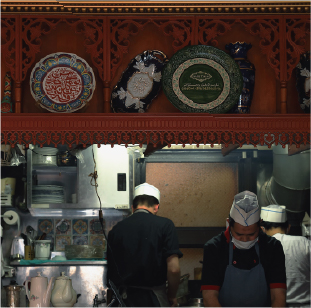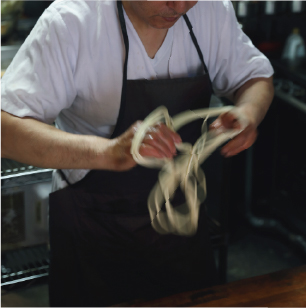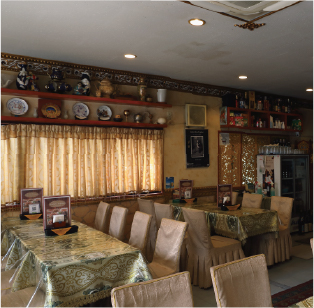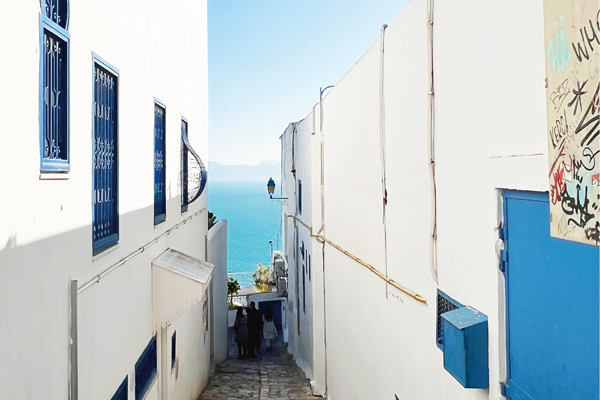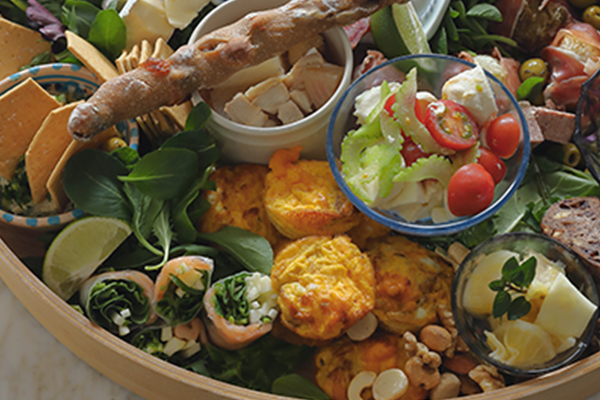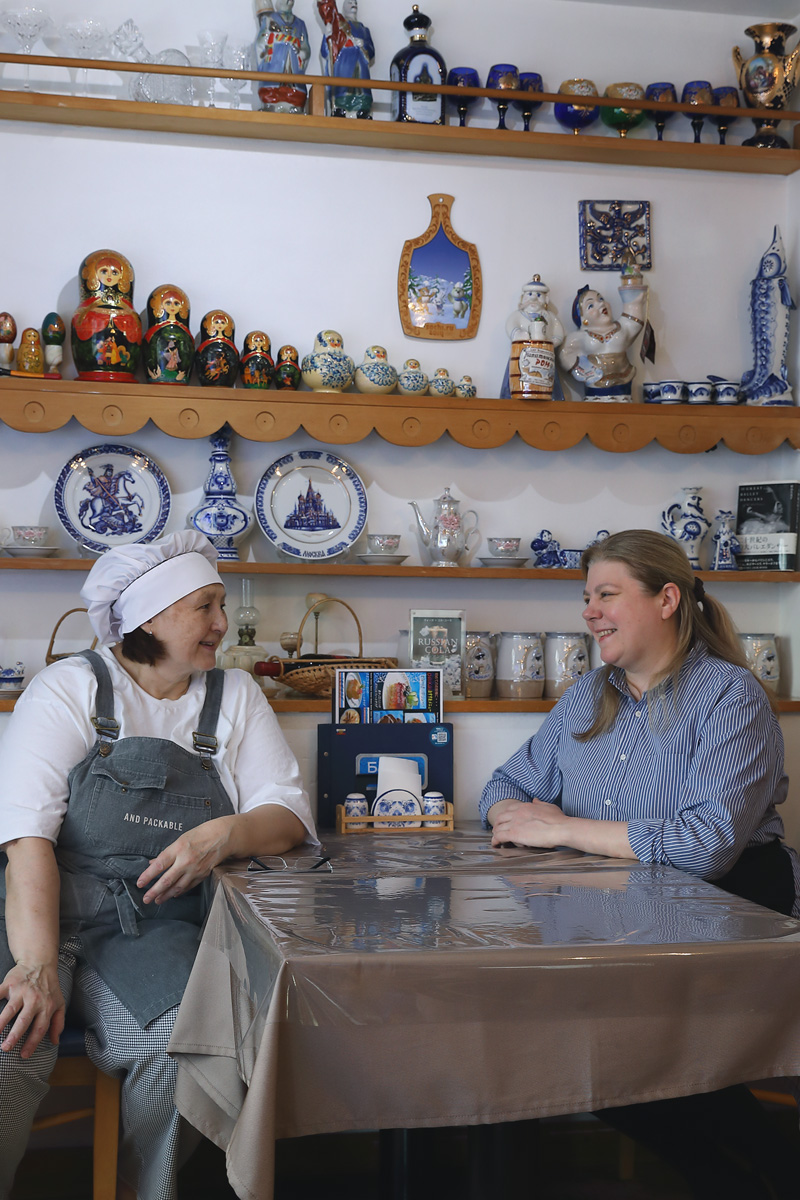
世界食堂。
世界食堂。
近所の外国人たちと友だちになりましょう、という話。

初めてのパリで、アフリカンたちで満員の 地下鉄に乗ったことがある。正直、不安だった。 肌の色が違い、言葉も通じず、みんな大きい。 でも、今ならなんとも思わない。アフリカンの友だちができ、 彼や彼女たちのことがわかったから。 今、日本に増えている在留外国人も同じ。 見た目が違っても、話をすればいい人だったりする。 友だちになれば、異国の文化を教えてもらえることもある。 そこで今号のyoffは様々な国の人が集まる食堂を特集。 食べて、飲んで、会話が弾んで、理解も深まる。 この号を読んで、身近にいる外国人と “お喋りしようかな” と思ってもらえるとうれしいです。
世界食堂。
Feature | 2025.6.24
近所の外国人たちと友だちになりましょう、という話。
初めてのパリで、アフリカンたちで満員の
地下鉄に乗ったことがある。正直、不安だった。
肌の色が違い、言葉も通じず、みんな大きい。
でも、今ならなんとも思わない。アフリカンの友だちができ、
彼や彼女たちのことがわかったから。
今、日本に増えている在留外国人も同じ。
見た目が違っても、話をすればいい人だったりする。
友だちになれば、異国の文化を教えてもらえることもある。
そこで今号のyoffは様々な国の人が集まる食堂を特集。
食べて、飲んで、会話が弾んで、理解も深まる。
この号を読んで、身近にいる外国人と
“お喋りしようかな” と思ってもらえるとうれしいです。
An invitation to befriend our neighbors from abroad.
I once boarded a Paris subway packed with Africans. Honestly, I felt uneasy—their skin color, their language, and their size, all different from mine.
But now, I wouldn’t think twice. I’ve made African friends and come to understand them.
Japan’s growing foreign community is much the same.
People may look different, but once you talk to them, most are kind.
Friendship opens the door to new cultures.
In this issue of yoff, we highlight eateries where people from many nations gather.
Food and conversation bring us closer.
May this issue inspires you to chat with someone new—right in your own neighborhood.

今の日本で欠かせない存在になっている在留外国人。
地域によっては問題も起きているけど、いないと日常生活は稼働しない。
海を越えて日本にやって来て、せっかくご近所さんになったんだから、彼や彼女たちのことをもっと知りたい。
一人ひとりと会話を楽しみ、理解し合う。つまり友だちになる。
そんなことが、これからの日本には大切なんじゃないかな。
Foreign residents are indispensable in today’s Japan.
Without them daily life would be hard.
They’ve crossed oceans to live here—
now that they’re our neighbors, let’s get to know them.
Enjoy conversations, build understanding, in short, become friends.
That might just be what Japan needs most moving forward.
東京で生活していると外国人を目にしない日がない。インバウンドの旅行客ではなく、在留外国人。コンビニに行けば笑顔で対応してくれて、建築現場では頼もしい働きっぷりを見せている。さらに居酒屋や介護施設、IT企業をはじめとしたオフィスなど様々な場所で活躍している。
法務省のホームページでは2024年末の在留外国人は376万8,977人、前年比35万7,985人(10.5%)の増加となっている。また、ある統計では2070年には939万人まで増えて総人口の10.8%を外国人が占めるという予測がされている。出生数が下がっていることとも関係して、これからの日本はますます外国人がいないとまわらなくなる。
隣に外国人がいる生活を経験してこなかった日本人には、この現状にとまどう人も多くいて、さまざまな問題が起きている。しかし、イメージだけで怖がったり、ヘイトへと向かうのは間違っている。必要なのは、私たち日本人がもっと、在留外国人たちを知ることなんじゃないかな。
そんな考えから、海外からやって来て日本で暮らす彼や彼女たちが集まるレストランに行ってみた。どの店も日本人向けのメニューではなく、本場の味をそのまま提供する、いわゆるガチ系。
その国の料理を味わいながら、お客として同席している在留外国人たちとコミュニケーションをとる。美味しいものは気持ちを寛容にし、会話を弾ませる。お酒が入ればさらにテンションは上がる。テーブルに並べられた料理についてあれこれ教えてもらい、その国の生活や文化へと話は広がる。どうして日本に来たの?日常生活で困っていることはない?などと聞いているうちに、国のことからその人のことへと話題が移り理解が深まっていく。
向かったのはロシア、エチオピア、インド、ウイグル。店の人たちは快く取材に応じてくれた。たどたどしい日本語で、それでも店を切り盛りしている。そして各店には、今夜もお国の人たちがやってきて、美味しい食事を楽しんでいる。
In Tokyo, you see foreign residents every day. Not tourists, but people who live and work here. They greet you at convenience stores with a smile and work hard on construction sites. They are also active in izakayas, nursing homes, IT firms, and many other workplaces.
According to the Ministry of Justice, Japan had 3,768,977 foreign residents at the end of 2024—up 357,985 from the previous year, a 10.5% increase. One forecast projects this number will reach 9.39 million by 2070, making up 10.8% of the total population. With its falling birth rates, Japan will increasingly rely on foreign residents to keep society running.
Many Japanese, unfamiliar with living alongside foreigners, struggle to adjust—and tensions can arise. But fear or hatred based on stereotypes is misguided. What we really need is simply to get to know them.
With that in mind, I visited restaurants run by foreign residents living in Japan and serving foreigners. These aren’t tourist-friendly spots—they serve real, local flavors from back home.
Over these meals, I chatted with fellow diners from abroad. Good food warms hearts and gets conversations flowing. With a drink or two, the mood lifts even more. They shared the stories behind their dishes, revealing glimpses of their culture and daily life. “Why did you come to Japan?” “What’s hard about living here?” Soon, the talk shifted from their country to their personal lives—and my understanding deepened.
I visited places run by Russians, Ethiopians, Indians and Uyghurs. Each welcomed me warmly. Their Japanese may be limited, but they run their businesses with confidence. Night after night, fellow nationals gather at these places to enjoy a taste of home.



チャーミングなお店で本場を味わう。ロシア料理の「六本木バイカル」。
Feature | 2025.6.24


[ ロシアンレストラン 六本木バイカル ]
レシピも食材も料理人もロシアにこだわって。
故郷の味を楽しみに人が集まる。
ロシアンレストラン 六本木バイカル
東京都港区六本木4-12-7 R.B.ビル3F
tel.03-5770-7742
六本木ミッドタウンの並び、外苑東通り沿いというメジャーなロケーションにあるロシア料理レストラン「六本木バイカル」。場所柄、敷居の高い店かと思っていたら、なんのことはなくとてもフレンドリー。
民芸品が並ぶ店内は素朴な雰囲気で、可愛いロシアが表現されている。ほっとしたこちらの気分をさらに和らげてくれるのが、店のマネージャーであるエレナ・エロステンコさんの笑顔。「私は独学で日本語を覚えました、だからあまり難しい話はできません(笑)」。
どうして六本木を選んだのですか?「このあたりのクラブにはロシア人たちが多く働いていて、ロシア大使館も近くにあります。そういった人たちのために、そしてもちろん日本人たちにも、本場のロシア料理を楽しんでもらうために2002年6月にオープンしました」。
この店の料理は日本人向けにアレンジされたものではない。「他のロシア料理店も、もちろんロシアのレシピを使っていると思います。でも、作っているのは日本人やアジア系の人たちが多い。料理とは不思議なもので、レシピどおりに作っても味は完成しません。作る人のセンスが大切で、それはロシアに生まれ育った人にはかないません」。
「六本木バイカル」は、本物のロシアの味を再現している。「シェフのジャネッタはずっとロシアで料理人をしていたので味は間違いありません。ロシアでは料理において伝統が尊重されます。店では、ずっと人々に愛されてきた、ロシアの家庭で親しまれているレシピを使っています。」
こういったロシア料理へのこだわりが多くの人を呼ぶ。「以前はロシア周辺国の人たちも来ていました。2011年の東日本大震災のときは、家に帰れなくなったロシア人をはじめ、ウズベキスタン人、グルジア(ジョージア)人、ベラルーシ人、ウクライナ人が10人以上、避難してきました。大丈夫だと言い合いながら一晩を過ごし、店からも食事やお酒を出してみんなを元気づけました。国を超えて一緒になって励まし合った、想い出に残る夜でした」。震災後は多くの外国人が日本から離れるなどで寂しくなったという。
とはいっても、今でもいろいろな人が来る。モンゴルやジョージアの方もお客さんだ。「たくさんの料理を食べて、みんな楽しく過ごします。盛り上がってきたらロシアの歌を唄います。よく唄われるのは『モスクワ郊外の夕べ』。故郷を想って、ノスタルジックな気分になります」。
今、ロシアに対していいイメージをもたない人もいる。「ロシア人は、本当は心が広く、優しい。もちろんそうではない人もいますが、多くはいい人。でも、つくり笑いができません」。愛想笑いが苦手なロシア人は、だから少し強面の印象があるのかも知れない。
エレナさんはハバロフスク生まれ。日本からも近い、アムール川がゆったりと流れる場所。古いロシアの面影が今も残る街で育ったエレナさんが店の詩をつくった。〜ネオンが灯る東京の空の下、一年中、寿司とラーメンが人気の街に、「バイカル」―ロシアが息づく小さな場所。ボルシチの香りが、ぬくもりを語りかける〜。ボルシチだけじゃなく、人のぬくもりもたくさん語りかけてくる、そんな店にロシアの人たちがやって来る。
Authentic Flavors in a Charming Setting—
Roppongi Baikal,
a Russian Restaurant Devoted to the Real Thing.
With Russian recipes, ingredients, and chefs,
it’s a place where people come for a taste of home.
Located in a prime location near Roppongi Midtown on Gaien-Higashi-dori, Roppongi Baikal may seem upscale, but it’s warm and welcoming.
The folk art–adorned interior evokes a cozy “little Russia,” and manager Elena Erostenko’s friendly smile puts guests at ease. “I taught myself Japanese, so I can’t handle complex conversations,” she laughs.
Why Roppongi? “Many Russians work at nearby clubs, and the Russian embassy is close. We opened in 2002 to serve authentic Russian cuisine—not just to Russians, but to Japanese guests too.”
The food here is not adjusted for Japanese tastes. “Other places may use real recipes, but often the chefs aren’t Russian. Cooking isn’t just about recipes—it’s about instinct, something only someone raised in Russia truly has.”
Roppongi Baikal offers true Russian flavor. “Our chef Janetta cooked professionally in Russia for years—her dishes are authentic. Russian cuisine values tradition, and we use home-style recipes passed down through generations.”
That commitment to authenticity draws a diverse crowd. During the 2011 earthquake, over ten people—Russians, Uzbeks, Georgians, Belarusians, Ukrainians—sheltered here. We supported each other through the night with food, drink, and words of comfort. I’ll never forget that night—we were united across borders.” Many foreigners left Japan after the quake, though, and things became quieter.
Still, a mix of people continue to come—Mongolians and Georgians among them. “They eat heartily and have fun. When the mood lifts, we sing Russian songs like ‘Evenings Near Moscow.’ It brings back memories of home.”
Some people today see Russia in a negative light. “But Russians are warm and kind. Of course, not everyone—but most are. We just aren’t good at fake smiles,” she says, noting that this may make them seem stern at first.
Elena was born in Khabarovsk, not far from Japan, on the wide-flowing Amur River. Raised in a city rich with old Russian charm, she even wrote a poem for her restaurant:“Beneath Tokyo’s neon sky,in a city of sushi and ramen,‘Baikal’—a little place where Russia breathes. The scent of borscht warms our hearts.” It’s not just the borscht—it’s the human warmth that keeps Russians coming back.

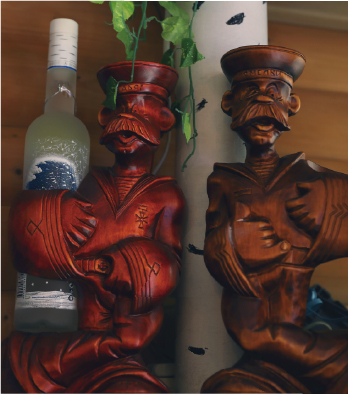

初めてのエチオピアが住宅街にあった。四ツ木の「リトルエチオピア レストラン&バー」。
Feature | 2025.6.24

[ リトルエチオピア レストラン&バー ]
在日エチオピア人が多く暮らす街で、
美味しい郷土料理を提供し、暮らしの世話もする。
Little Ethiopia Yotsugi
東京都葛飾区東四つ木3丁目23-6
tel.03-6323-3983
Facebook:https://www.facebook.com/Enkifat.yotsugi/
YouTube:https://youtube.com/channel/UCsyC3m4ENwmxI_KsohvxB6Q
Web:https://little-ethiopia.net/
京成電鉄の四ツ木駅周辺はリトルエチオピアと呼ばれるほど、エチオピア人が多く住む。そんな街の中に「リトルエチオピア レストラン&バー」がある。
普通の住宅街にある店、しかし一歩入ればそこは異国。匂い、装飾品、聞こえる言葉ですっかり海外気分に。女性オーナーのメンベレ・ティベベさんと夫のハイレ・エフレムさんに「リトルエチオピア レストラン&バー」の成り立ちから聞いてみた。「オープンしたのは2016年です。最初はコーヒーショップとしてオープンする予定でした。しかしそこに集まったエチオピア人たちから料理やお酒も出してほしいというリクエストがあり、今のレストラン&バーになりました」。
客の割合は日本人が70%で海外からの観光客が20%。残りの10%が在日エチオピア人というが、もっと多い感覚がある。前回に来たとき、店内にはエチオピア人しかいなかった。「四ツ木には多くのエチオピア人が住んでいて、その人たちを頼って、またエチオピア人がやって来る。それを繰り返しているうちに人数が増えてきました。新しくやって来たエチオピア人が家を借りたり、仕事を探す手伝いを僕がしています」。面倒見のいいエフレムさんのもとにみんなが集まる。
日本人がエチオピアと聞いて思い浮かべるのはマラソンとコーヒーくらいか。そんなエチオピアってどんな国だろう。「エチオピアは古く、人類が始まった国ともいわれています。80以上の言語があり、顔つきや肌の色もさまざまです。文化も豊かで、宗教はエチオピア正教というキリスト教の他にイスラム教もあるけど一度も喧嘩をせずに仲良くやっています」。
エチオピア人は陽気で人が良く、みんなで集まるのが大好き。「エチオピアにはコーヒーセレモニーというものがあります。まず、コーヒーをより美味しくする香りのインセンスを焚きます。その匂いにつられて人が集まる。ときには通りすがりの人も来ます。みんなが集まり、コーヒー豆を焙煎し、ジャバナという土器のポットでコーヒーを淹れます。1時間以上かけてセレモニーをすることもあります。その間、お喋りをしながらさまざまな情報を交換します。エチオピア人にコーヒーセレモニーは欠かせません。ウチの店でもやっていますよ」。
「リトルエチオピア レストラン&バー」ではほとんどの料理はトラディショナル。エチオピアの日常食は、日本ではなかなか食べられない。「シェフはエチオピア人だし、たまに僕の奥さんも料理づくりを手伝います。日本にない食材は輸入します。だから味は本物。普段もエチオピア人が来ますが、エチオピアのナショナルデイをはじめキリスト教やイスラム教の祭事がある日、そして結婚式や誕生日など、イベントのある日は特に盛り上がります」。
エフレムさんは奥さんと娘の日本のビザを取るために何年も奮闘し、その様子はNHKのドキュメンタリー番組にもなった。「いまは奥さんと二人の子どもがいて、楽しく暮らしています。これからも家族とエチオピアの仲間たちと、日本で暮らしていきたいと思っています」。
近くの工場や商店街で働く人たちが、同じ国の仲間と食事やお酒、コーヒーを楽しみに「リトルエチ オピアレストラン&バー」に集まる。そんな場所があるエチオピア人たちがうらやましく思えた。
My First Taste of Ethiopia Was in a Residential Neighborhood:
Little Ethiopia Restaurant & Bar in Yotsugi.
In a neighborhood with a strong Ethiopian presence,this welcoming spot
offers authentic dishes—and a helping hand with everyday life.
The area around Yotsugi Station on the Keisei line is home to so many Ethiopians, it’s nicknamed “Little Ethiopia.” Tucked into this neighborhood is the Little Ethiopia Restaurant & Bar.
It’s located in an ordinary residential area, but step inside, and you’re transported. The aromas, décor, and language create the feeling of being in another country. I spoke with the owners, Membele Tibebe and her husband, Haile Efrem, about how the restaurant began. “We opened in 2016. Originally, we planned just a coffee shop,but local Ethiopians asked us to serve food and alcohol too—so it became a full restaurant and bar.”
About 70% of customers are Japanese, and 20% are foreign visitors. Only 10% are Ethiopian residents, but it feels like more. Last time I visited, the place was filled entirely with Ethiopians. “Many Ethiopians live in Yotsugi. Others move here to be near them, and over time, the community has grown. I help newcomers find housing and work.” Under Efrem’s warm care, people naturally gather.
To many Japanese, Ethiopia means coffee and marathons. But what is it really like? “It’s ancient—some say the birthplace of humanity. There are over 80 languages, and people vary in looks and skin tone. It has rich culture, and both Ethiopian Orthodox Christianity and Islam coexist peacefully—we’ve never had religious conflict.”
Ethiopians are cheerful and community-oriented. “We have a tradition called the coffee ceremony. We burn incense to enhance the aroma, which draws people in—even passersby. Then we roast beans and brew coffee in a clay pot called a jebena. It can take over an hour, with lots of chatting and sharing news. It’s essential to our culture—we do it here at the restaurant, too. ”
Most dishes at Little Ethiopia are traditional. Ethiopian everyday foods are rare in Japan. “Our chef is Ethiopian, and sometimes my wife helps in the kitchen. We import ingredients you can’t get in Japan, so the flavor is authentic. Ethiopians visit regularly, but the place really comes alive on holidays—Ethiopia’s national day, religious festivals, weddings, and birthdays.”
Efrem spent years fighting to obtain visas for his wife and daughter—a story that was featured in an NHK documentary. “Now I live happily with my wife and two children. I want to continue living in Japan—together with my family and Ethiopian friends.”
Workers from nearby factories and shopping streets come to enjoy food, drinks, and coffee with fellow countrymen at Little Ethiopia. I found myself envying the Ethiopians for having a place like this.
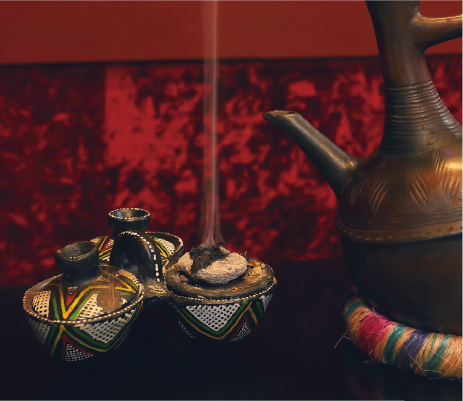
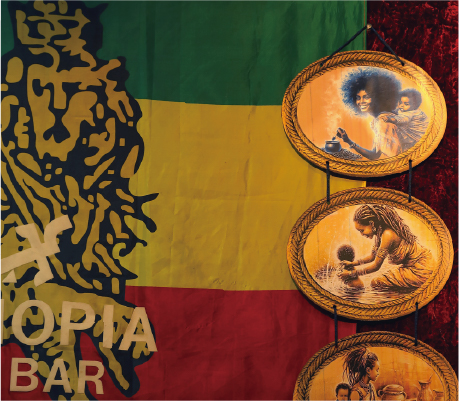
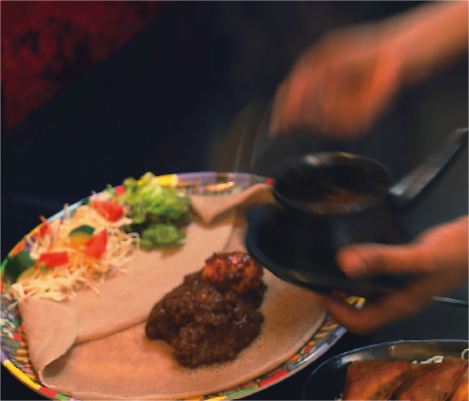
多くのインド人が帰る場所。西葛西、リトルインディアの「Oh バイヤ!」。
Feature | 2025.6.24
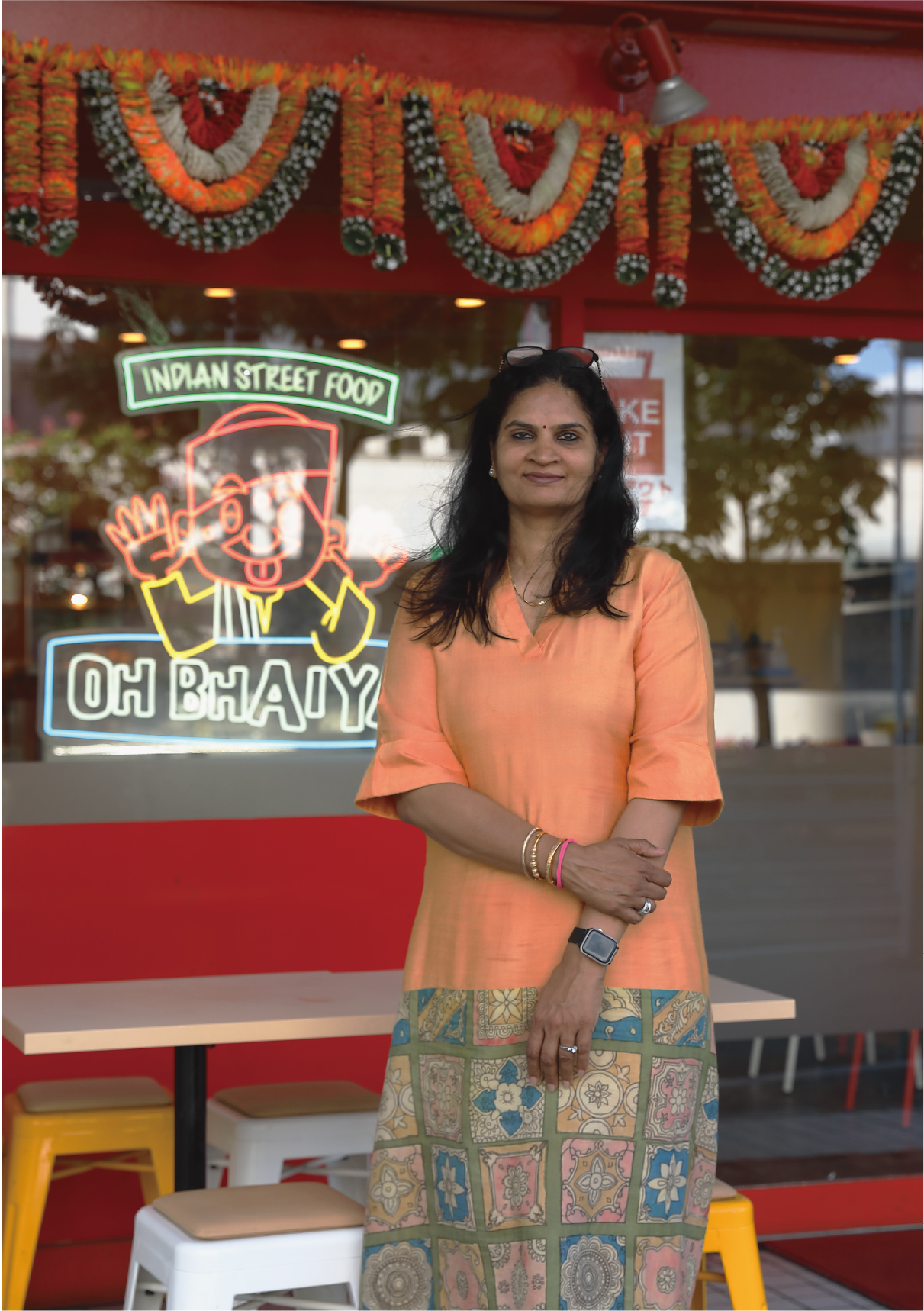
東京都江戸川区にリトルインディアと呼ばれている地域がある。東京メトロ東西線「西葛西」駅周辺。この街には、とにかくインド人が多い。ヒンディー語の看板を掲げる食料品店やレストランも目につく。
2030年、東京都内在留のインド人は約17,000人、そのうち約5,100人が江戸川区在住という。たぶん、そのほとんどが西葛西にいるのではと思うほどの、ここはまさにリトルインディア。
そんな街でインド人たちが日常使いしているレストラン、「Ohバイヤ!」を訪ねた。取材に応じてくれたのは店のマネージング・ディレクター、ヒンガル・プリティさん。
「『Ohバイヤ!』の母体となっているのは『アンビカ・ショップ』というインド食材輸入品店です。蔵前や新宿などに4店舗あり、さまざまなスパイスをはじめとしたインドの食品を販売しています。西葛西にも店舗があるので、この街はよく知っていました。ここには多くのインド人が住んでいて、独身で、知り合いもあまりいない人もいます。そんな人たちに美味しいインド料理を食べてもらいたいと思い『Ohバイヤ!』をはじめました」。
メニューを見ると、知らない料理が並んでいる。「日本の人たちはインド料理というとみんな カレーとナン(笑)。ここで出しているのはインドの屋台料理で、インドでは気軽に毎日、食べられているもの。ナンはありません。さらに、すべてベジタリアンやヴィーガン料理なので、健康にいいです」。
写真がついたメニューをめくると、とにかく種類が多い。インド南部のカジュアルな食事、ティファンも多くある。
「インドでは同じ食べ物でも地方によって味付けや素材が変わります。その違いをカバーしようとすると品数が増える。でもこれなら、インドのどの地方の人も美味しく、懐かしく、食事ができます」。
日本人が食べやすい味にするのではなく、インドのどの地方の人も納得できる味にする。結果、本場の味だということでインド好きの日本人たちもやって来る。「お客さんの40%くらいは日本人で、あとはインド人。店ではさまざまなイベントも行っています。新しく日本に越してきた人へのウエルカムパーティ、インドの記念日に合わせた食事会、またタブラー(北インドの打楽器)を使ったライブや舞踊などインド文化を紹介するイベントも行っています」。
毎日のように通う人のための会員制のメニューも用意されている。「共働きで料理ができない人や未婚の人のためのメニューです。メンバーは、1回のランチが700円、ディナーは900円、両方だと1,500円で、月に14回食べることができます。もちろんテイクアウトもOKです」。
そうして『Ohバイヤ!』は西葛西のインド人たちの行きつけの店になっている。「このあたりの集合住宅は、多いところでは住人の90%がインド人というところもあります。そんな人たちが自分の家の食堂のように使ってくれています。店名の『Ohバイヤ!』にはお店で店員さんを呼ぶときの “ちょっと、すみせん” のような意味合いがある。 “お兄さん、これ作って!” という感じ。そんな気軽さで、みんなここで食事を楽しんでいますよ」。
取材中も一人でふらりと、インド人たちが訪れていた。平日の昼下がり、「Oh バイヤ!」にはインドの普通の生活があった。
Oh Bhaiya!
in Nishi-Kasai, Tokyo’s Little India:
A place many Indians call home, serving wholesome,
casual Indian cuisine for those living far from home.
There’s a neighborhood in Edogawa Ward, Tokyo, known as Little India, centered around Nishi-Kasai Station on the Tokyo Metro Tozai Line. This area has a large Indian population, and many grocery stores and restaurants have signs in Hindi.
Of Tokyo’s 17,000 Indian residents (as of 2023), over 5,000 live in Edogawa—most in Nishi-Kasai.
I visited Oh Bhaiya!, a go-to spot for locals, and spoke with Managing Director Priti Hingarh.
“Oh Bhaiya! was started by Ambika Shop, an Indian grocery importer with four locations, including Kuramae, Shinjuku, and Nishi-Kasai. So I knew that Nishi-Kasai has many Indians—especially singles—lacking support. Wanting to offer them good Indian food, I opened this restaurant.”
The menu features dishes unfamiliar to most Japanese diners. “Japanese people think Indian food is just curry and naan,” she laughs. But we serve everyday Indian street food—no naan. It’s all vegetarian or vegan, so it’s healthy too.”
The menu with photos offers great variety, including many South Indian tiffin dishes. “Even the same dish varies from region to region in India, different spices and ingredients, so we offer various versions. That way, people from across India can enjoy food that feels like home.”
Instead of adapting to Japanese tastes, the focus is on flavors that appeal to Indians from any region. That authenticity also attracts Japanese fans of Indian food. “About 40% of our customers are Japanese. We also host events—welcome parties for newcomers to Japan, Indian holiday meals, and cultural events such as tabla music and dance performances.”
They even have a membership meal plan for regulars. “It’s designed for busy people or singles unable to cook. Members pay ¥700 per lunch, ¥900 for dinner, or ¥1,500 for both—14 meals per month. Takeout is also available.”
So “Oh Bhaiya!” has become the go-to place for Indians in Nishi-Kasai. “In some apartment buildings around here, 90% of the residents are Indian. They treat this place like their own home kitchen. The name ‘Oh Bhaiya!’ is something you’d say to casually call over a server—like ‘Hey, brother, make me one of those!’ It’s that casual spirit that makes everyone feel comfortable eating here.”
Even during the interview, Indian customers strolled in on their own. On that quiet weekday afternoon, “Oh Bhaiya!” offered a taste of ordinary life in India.
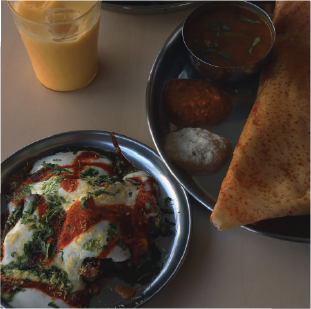
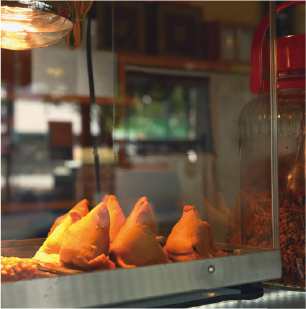
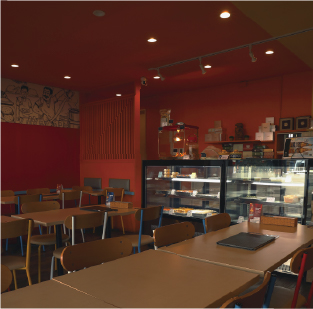
美味しいウイグルを日本に馴染ませる、初台の「シルクロード・タリム」。
Feature | 2025.6.24
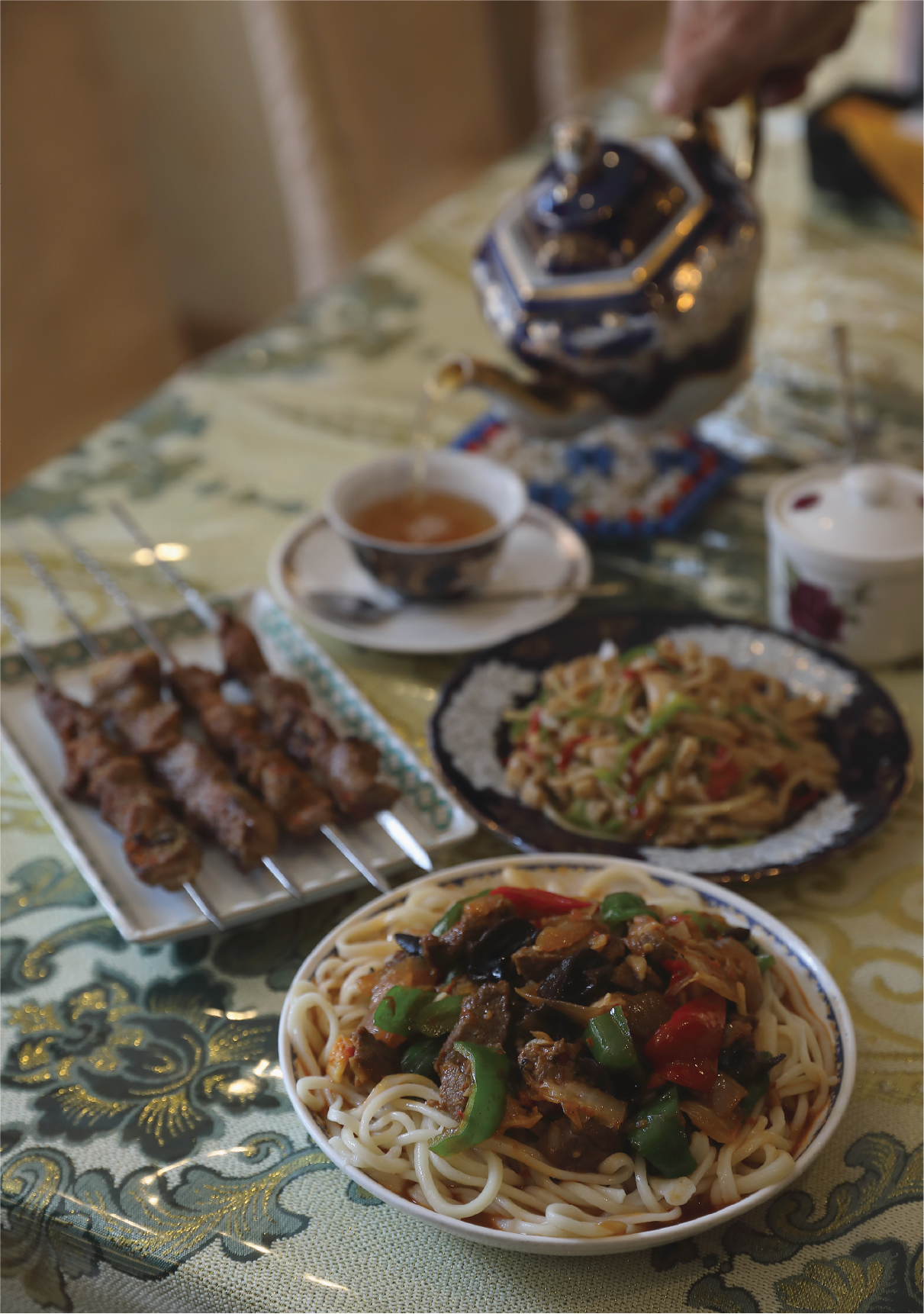
[ シルクロード・タリム ウイグルレストラン]
ウイグル人であることを大切にしながら、
第二の故郷である日本を愛する。
シルクロード・タリム ウイグルレストラン
東京都新宿区西新宿3丁目15-8-103 (西新宿バールビル1階)
tel.03-6276-7799
新疆ウイグル自治区は中国にある5つの自治区のひとつ。暮らしているのはトルコ系の少数民族で、中国で大多数を占める漢民族とは文化も言語も顔立ちも違い、ほとんどがイスラム教徒。中国政府から弾圧を受け国際的な問題となっている。そんななか、日本に来るウイグル人は多い。
新宿の近く、初台にあるウイグルレストラン「シルクロード・タリム」を経営する塔里木スラジディンさんも若い頃にウイグルから日本へやって来た。 「私は2001年、日本に留学で来ました。 大学を卒業後、 企業に就職して経営の管理システムなどを学び、2010年に『シルクロード・タリム』をオープンさせました」。
日本人がウイグルを知らなかったことが、レストラン経営につながった。「当時、ウイグルから来たというと “モンゴルからですか?” と聞かれる。日本人がウイグルのことを知らないのが残念で、どうにかできないかとあるボランティアの先生に相談しました。すると先生から“あなたは飲食の経験があるからそれを活かしなさい”とアドバイスをもらいレストランを始めました」。
場所を初台にしたのは、代々木上原にモスクがあったから。「代々木上原に東京ジャーミイというモスクがあります。そこになるべく近い場所をと、初台にしました。当時はハラルの店が少なく、日本に住むムスリムたちは食事に困っていました。そんなこともあり、店にはウイグル人たちが多く訪れるようになりました」。
みんな、本場の味を求めて集まってくる。「店では本場の味にこだわり、スパイスなどを現地から輸入。お客さんはラグメンやケバブなど、故郷の味を楽しんでいますよ」。 スラジディンさんはウイグルにいる頃から日本文化の影響を多く受けたという。「初めて買ったバイクが日本製。テレビも日本製で、映画は高倉健の『君よ憤怒の河を渡れ』が好きでした。ウイグルでは、初めて知る海外が日本でした」。
憧れていた日本に暮らしても、やっぱり故郷は恋しくなる。そんなウイグル人たちが楽しみにしているのがノウルーズという儀式。「3月20日に行われる春の到来を祝うお祭りです。毎年、300人ほどが集まり、着飾り、ご馳走を楽しみます。この儀式に出される料理は私の店から提供しています」。
自分たちの文化を大切にしながらも、日本に馴染んでいこうとしているウイグル人たち。「日本人はとても真面目で大好きです。でもたまに、冷たい人もいて、不安になることがあります。私は今、日本国籍をもち、その日本を愛しています。第一の故郷を失った私は、第二の故郷も失いたくはありません」。きっと大丈夫ですよ、スラジディンさん。これからもずっと、ここ初台で美味しいウイグル料理を食べさせてください。
Introducing Uyghur Flavors to Japan:
Silk Road Tarim in Hatsudai.
Honoring his Uyghur identity while embracing Japan as a second home.
The Xinjiang Uyghur Autonomous Region is one of five autonomous regions in China. Home to a Turkic Muslim minority with its own language and culture, Uyghurs differ from the Han majority and have long faced government repression, causing many to emigrate to Japan.
Tarim Sirajidin, who runs the Uyghur restaurant Silk Road Tarim in Hatsudai near Shinjuku, came to Japan as a student in 2001. After studying management at a company post-graduation, he opened the restaurant in 2010.
Few Japanese knew about Uyghurs, which led Sirajidin to open the restaurant. “Back then, when I said I was from Uyghur, people would ask, ‘From Mongolia?’ I found that sad and spoke to a volunteer teacher, who said, ‘You have food service experience—use it.’ That’s how the restaurant began.”
He chose Hatsudai for its closeness to the Tokyo Camii mosque in Yoyogi-Uehara. “There were few halal restaurants back then, and many Muslims had trouble finding food, so many Uyghurs began coming to my place.”
People come for the authentic taste. “We import spices and ingredients from home, and serve dishes like laghman and kebabs—true flavors of our homeland.”
Even while Sirajidin was still living in Uyghur, Japanese culture left a mark. “My first motorcycle was Japanese. My TV was Japanese, too. And I loved Ken Takakura’s film Manhunt. Japan was our first window to the world.”
Even after realizing his dream of living in Japan, he still misses home. A celebration Uyghurs in Japan look forward to is Nowruz. “It’s a spring festival held on March 20. Around 300 people dress up and come together to enjoy a feast—and my restaurant provides the food.”
Uyghurs in Japan strive to preserve their culture while fitting in. “I admire the sincerity of Japanese people, though at times they can seem distant. I’m now a Japanese citizen and love this country. Having lost one homeland, I don’t want to lose another.” You’ll be just fine, Sirajidin—please keep delighting us with your delicious Uyghur cuisine in Hatsudai.
